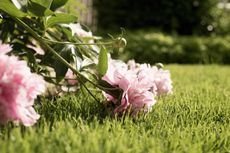Environmental Problems
Cultural plant problems and various types of environmental issues are inevitable, regardless of how well you care for your garden. So what is a gardener to do? The first step to solving gardening issues caused by environmental problems in gardens is to do your research. The pages that follow will help with that. With information for dealing with types of environmental issues like contaminated soil, floods, heat waves or cold spells, you’re sure to find something that relates to the particular needs of your garden. So keep reading to learn more.
Environmental Problems
-

Care Of Damaged Plants: Information For Salvaging Injured Plants
Nothing is more disconcerting than to discover a problem with your plants. With a little know how from this article, you can find ways for reviving stress damaged plants and making them well again.
By Amy Grant
-

Hail Crop Damage: How To Care For Hail Damaged Plants
You can feel the ping of hailstones on your skin and your plants can too. Hail crop damage can severely decimate the harvest. This article will help with repairing or preventing this damage.
By Bonnie L. Grant
-

Plant Leaves Turning White Or Pale: Learn About Plant Sunburn Damage
There's nothing like the smell of new plants, but when your plants are turning white, the fun is over. Established plants can also suffer the same fate. Find out what causes white-colored damage on plants and how you can prevent it in this article.
By Kristi Waterworth
-

Reducing Soil Erosion: Using Plants For Erosion Control
Reducing soil erosion is important to preserve nutrient-rich soils and natural or unnatural topography. Using plants for erosion control is an excellent method. This article will provide more info.
By Bonnie L. Grant
-

What Is Sunscald: Learn About Sunscald On Plants
Did you know that plants and trees can get a sunburn just like human beings? Much like our sunburn, sunscald on plants damages the outer layer of a plant's skin. Read this article for tips on treating sunscald.
By Anne Baley
-

Torrential Rains And Plants: What To Do If Rain Is Knocking Down Plants
Rain is as important to your plants as sun and nutrients, but like anything else, too much of a good thing can spell trouble. Learn what to do for plants knocked down by rain in this article.
By Kristi Waterworth
-

What Is Replant Disease: Advice For Planting Where Other Plants Died
Planting where other plants died is possible but only if you take appropriate actions, especially when disease issues are involved - which may result in replant disease. Learn more in this article.
By Susan Patterson
-

Leaf Gall Identification: Learn About Preventing And Treating Leaf Gall On Plants
Odd little bumps on leaves and funny protuberances on plant leaves may be a sign of pest, bacterial, or fungal problems. Leaf galls are actually harmless but it helps to know what causes them. Learn more here.
By Bonnie L. Grant
-

Established Plants Are Tall And Leggy: What To Do For Leggy Plant Growth
Plants that become leggy or floppy tend to fall over, produce less flowers and produce and create an untidy spindly appearance. There are a couple of reasons why plants are tall and leggy. Learn what they are in this article.
By Bonnie L. Grant
-

Herbicide Plant Damage: How To Treat Plants Accidentally Sprayed With Herbicide
Herbicide plant damage is usually the result of unintentional contact with chemicals from spray drift or contact with vapor. Recognizing accidental herbicide injury may be difficult, but this article can help.
By Bonnie L. Grant
-

Variegated Plant Problems: What Causes Reversion Of Variegated Leaves
Reversion of variegated leaves occurs in many types of plants. This is when the white shading or lighter speckles and borders turn into green. This is frustrating to many gardeners. Learn more here.
By Bonnie L. Grant
-

Flood Damage Clean Up: Tips For Minimizing Flood Damage In The Garden
Heavy rainfall followed by flooding not only causes damage to buildings and homes, but can also affect plants in the garden. Learn how to manage flooded garden plants in this article.
By Nikki Tilley
-

Signs Of Under Watering Plants: How Can You Tell Plants Have Too Little Water
Not enough water is one of the most common reasons that plants are unhealthy, wilt, and die. It’s not always easy, even for expert gardeners, to get watering right. To avoid problems associated with under watering, know the signs to look for. This article will help.
By Mary Ellen Ellis
-

Does Weather Affect Plant Growth: Effect Of Temperature On Plants
Does weather affect plant growth? It sure does! It's easy to tell when a plant has been nipped by frost, but high temperatures can be just as harmful. There is a considerable disparity when it comes to temperature stress in plants. Learn more here.
By Mary H. Dyer
-

What Is Light Frost: Information On The Effects Of Light Frost
Nothing takes the smile off of a gardener's face quicker than an early fall or a late spring frost. Read this article to find out what is light frost and plant frost info for plants affected by light frost.
By Susan Patterson
-

Tips For Care Of Plants And Flowers In Hot Weather
When temps rise above 85 degrees F., many plants inevitably suffer ill effects. With adequate care, effects of heat stress can be minimized. Learn more here.
By Nikki Tilley
-

Home Construction And Gardens: Tips On Protecting Plants During Construction
Every plant in the garden has the potential to become injured during construction, but with a few helpful tips from this article, you should be able to protect your plants during construction of new additions, garages, etc. in the landscape.
By Bonnie L. Grant

